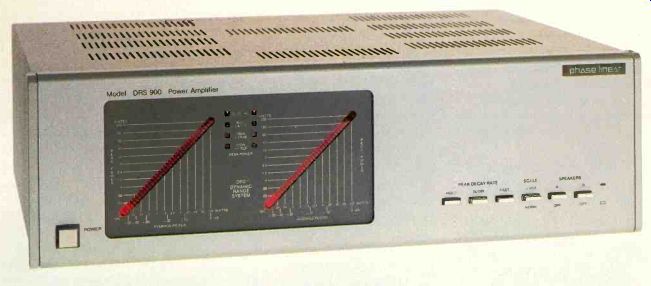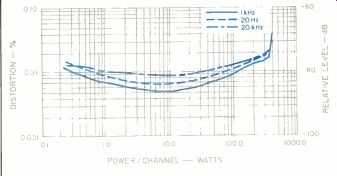
Manufacturer's Specifications:
Power Output: 150 watts per channel. 8 ohms, 20 Hz to 20 kHz.
Rated THD: 0.015%.
Frequency Response: 10 Hz to 40 kHz, +0,-1.0 dB.
SMPTEIM: Less than 0.009%.
S/N: 100 dB.
Damping Factor: 330 at 1 kHz.
Input Impedance: 49 kilohms.
Input Sensitivity: 0.8 volts rms for 150 watts output.
Slew Rate: 100 volts/microsecond.
Rise Time: Less than 1.0 microsecond.
Power Requirements: 120 V a.c., 60 Hz. 350 watts.
Dimensions: 17 1/2 in. (44.5 cm) W x 10 1/2 in. (26.7 cm) H x 18 in. (45.7 cm) D.
Weight: 38 lbs. (17.3 kg).
Price: $1095.00.
Company Address: 4134 N. United Parkway, Schiller Park, Ill. 60176.
When I tested Phase Linear's CD player a few months ago, it was delivered to me personally by some of the marketing and engineering people from the company. At that time, they noticed that I also had (among the many pieces of audio equipment waiting to be tested) their new DRS 900 power amplifier. They urged me to listen to the CD player (theirs or anyone else's) using that amplifier. Now I know why! Given the awesome dynamic range of CD software, the more headroom an amplifier has, the more likely it will be able to reproduce those CD disc peaks without sending the amp into momentary (but audible) clipping. In the case of the Phase Linear DRS 900, the reserve power isn't just limited to short-term peaks; I was able to push the amp to an output level of more than 350 watts even using a steady state sine-wave tone. Using the EIA tone-burst signal specified for measuring dynamic headroom, I came up with a figure of 4.0 dB. To the best of my recollection, that's the highest dynamic headroom I've ever measured for any high fidelity power amplifier. Remember, this amp has a nominal rating of 150 watts per channel; adding 4 dB of dynamic headroom to that means that it can handle short-term peaks of up to nearly 377 watts without any sign of peak clipping.
But I'm getting ahead of myself; let's take a look at the physical layout of the DRS 900.
The front panel of this amplifier is equipped with a most unusual power metering system for each channel. It offers a simultaneous display of peak output power (in the form of a "dot" indicator light) and average output power (in the form of an illuminated "bar"). Located between the two dynamic metering displays are two columns of red LEDs, calibrated for peak output power, and a yellow LED which indicates clipping. The on/off switch for the amplifier is located at the lower left of the front panel. Three pushbuttons to the right of the panel meters control the rate of decay of the peak-indicating "dots" in the metering system. Those labeled "Slow" and "Fast" control the speed of the dots' descent, while the "Hold" button allows the highest dot position to be held for later observation or reference.
Three more buttons are located to the right of these switches. The first of these expands the meter range when it is depressed, changing full-scale readings by a factor of 10 to one. The remaining two buttons, which may be pushed singly or in combination, select either or both possible sets of speakers.
The rear panel of the DRS 900 has a pair of phono-tip input jacks at the left, two pairs of color-coded, 5-way speaker-wire binding posts near the center, and a line fuseholder containing a 10-ampere, 250-volt line fuse. There are no fuses in the speaker output circuits, but Phase Linear does recommend appropriate fusing of whatever loud speakers are to be used with this amplifier.
Circuit Highlights
The Phase Linear DRS 900 has two positive and two negative power supplies, each pair with different maximum voltages. When the voltage across the base and collector of the output transistors (that is, the difference between the supply and signal voltages) falls low enough to threaten non-linear operation of these transistors, the higher voltage power supply is automatically switched to the output stage.
This automatic power-supply selection occurs independently for the positive and negative halves of the output stage more efficient than powering both halves from a high-voltage supply when only one polarity of the program signal requires the additional voltage.
The power supplies of this amplifier, according to Phase Linear's engineers, have been designed to provide adequate energy reserves for even highly compressed program material. All power-handling components, including trans former, heat sinks and semiconductors, have been selected or designed for long-term operation. All power-supply switching (except for on/off switching) is done after rectification and filtration to ensure freedom from line-frequency voids when an instantaneous burst of power is required.

Fig. 1--Power output vs. distortion, 8 ohms.
Laboratory Measurements
For an amplifier rated at 150 watts per channel, the actual steady-state power output capabilities of this product completely surprised me. The DRS 900 delivered 360 watts per channel at mid-frequencies; not for brief periods using pulses or tone bursts, but continuously. Phase Linear might well have given the DRS 900 an "official" rating of 325 watts per channel (it delivered 331 watts at the standard 20 Hz and 20 kHz test frequencies), but they probably refrained from doing so since that would have necessitated an FCC one-hour preconditioning test at a constant output level of 118 watts or so, which might have produced an excessive amount of heat. In our own tests, preconditioning for one hour was done at 50 watts (one third the "official" power rating) and the amplifier came through without any difficulty.
A plot of power output versus harmonic distortion is shown in Fig. 1. SMPTE-IM at rated power or below measured 0.006%. CCIF-IM (using the twin-tone method of measurement and reading any IM-produced 1-kHz component as a percentage of the combined equivalent level of the two tones) measured only 0.0037%. IHF-IM was too low to be observed with our spectrum analyzer, whose dynamic range is limited to 80 dB (corresponding to an equivalent percentage of 0.01°4 Frequency response of the amplifier extended from 13 Hz to 95 kHz for a 1-dB roll-off and from 6.5 Hz to 190 kHz for a 3-dB roll-off. Damping factor measured in excess of 200, limited no doubt by the very short length of 14-gauge wire which I use between an amplifier's output terminals and the inputs to my test setup. Dynamic headroom, as already mentioned, was an incredibly high 4.0 dB. Input sensitivity for 1 watt of output into 8-ohm loads was 76 mV, which works out to 930 millivolts for 150 watts of output. The amplifier was unconditionally stable under no-load and 2-RF capacitance load conditions. While no power specification is given for 4-ohm operation of the amplifier, we did test it under 4-ohm and 2-ohm load conditions and found it to be stable under these load conditions as well. The A-weighted signal-to-noise ratio, referred to 1 watt, measured 90 dB; referred to 150 watts, that would be 111.7 dB. If you want to reference the noise to the short-term peak-power capability of this amplifier, you can add another 4 dB or so to the S/N number, for a total "dynamic range" between clipping and noise floor of nearly 116 dB. When Phase Linear states (in their owner's manual) that this amplifier has more than enough dynamic range to handle any 16-bit digital audio program source, they aren't kidding!
Use and Listening Tests
While I no longer had the Phase Linear CD Player at the time that I tested this amplifier, I did have two other CD players on hand, as well as a wider selection of CDs. (The discs were acquired during a recent trip to Eindhoven, The Netherlands; Hasselt, Belgium, and Hannover, West Germany, where I and several other guests of Magnavox, Philips and Polygram were shown the intricacies of CD player and disc manufacturing.) Suffice it to say here that the DRS 900 is ideally suited to this type of program source. At average listening levels of between 1 and 5 watts, (the metering system is ideal for determining such things), peaks as high as 200 watts occurred during the playing of some of these discs. Take, for example, a Philips sampler which contains 14 pop and classical selections. I expected the cut of Kabalevsky's "Colas Breugnon" (performed by the Boston Pops, under John Williams) to exhibit showy dynamics, and it did. I was surprised at how much power was required to properly reproduce a piano's percussive sounds when I listened to Chopin's Fantasie-Impromptu in a performance by Bella Davidovich. I think most of us have never realized just how much compression is being applied to piano works recorded and pressed on standard LPs. Happily, the Phase Linear DRS 900 was up to the task of handling these short- and long-term fortes from CDs with an effortlessness that nicely complemented the new discs and players.
It almost goes without saying that an amplifier able to do this well with the most demanding of source material did equally well when presented with more traditional forms of program sources. It was flawless with Dolby C cassette tapes that I consider to be well recorded, FM programs received from the one station in my listening area that avoids compression almost entirely and-yes-even some of my favorite direct-to-disc and digitally mastered LPs. In short, the Phase Linear DRS 900 is an amplifier for now and for the foreseeable future.
-Leonard Feldman
(Audio magazine, Sept. 1983)
Also see:
Phase Linear Model 2000 Preamplifier (Equip. Profile, Sept. 1976)
Phase Linear Model 3000, Series H Preamplifier (Jan. 1979)
Phase Linear 400 Amplifier (Feb. 1973)
Phase Linear 4000 Preamplifier (Equip. Profile, Nov. 1975)
= = = =